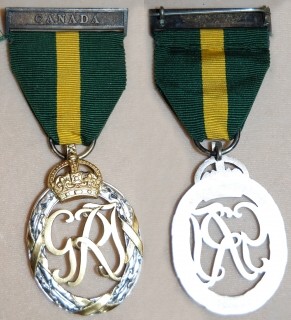The Canadian Forces Decoration is a Canadian award bestowed upon members of the Canadian Armed Forces who have completed twelve years of military service, with certain conditions. By convention, it is also given to the Governor General of Canada upon his or her appointment as viceroy, which includes the title of Commander-in-Chief in and over Canada. The decoration is awarded to all ranks, who must have a good record of conduct during the final eight years of claimed service.
Orders and decorations conferred to civilians and military personnel in Singapore, listed by order of precedence. Awards specific to the military or police forces are separately listed. All state orders and decorations are styled in the Malay Language.
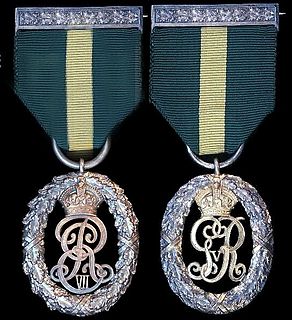
The Territorial Decoration (TD) was a military medal of the United Kingdom awarded for long service in the Territorial Force and its successor, the Territorial Army. This award superseded the Volunteer Officer's Decoration when the Territorial Force was formed on 1 April 1908, following the enactment of the Territorial and Reserve Forces Act 1907, which was a large reorganisation of the old Volunteer Army and the remaining units of militia and Yeomanry. However, the Militia were transferred to the Special Reserve rather than becoming part of the Territorial Force. A recipient of this award is entitled to the letters "TD" after their name (post-nominal).
The orders and decorations conferred upon civilians and military personnel in the Republic of the Philippines, are listed by order of precedence. The first list is of civilian awards, which take precedence over and above military awards. The next list is of awards conferred upon the military or formerly military units. Philippine civilian orders and decorations are conferred by the President of the Philippines, in his or her capacity as head of state. In certain instances, the conferment of certain orders and decorations requires the concurrence of the Congress of the Philippines, or of certain advisory bodies.
An overview of South African military decorations and medals, which form part of the South African honours system.
The following is the Canadian order of precedence for decorations and medals. Where applicable, post-nominal letters are indicated.

The Volunteer Officers' Decoration, post-nominal letters VD, was instituted in 1892 as an award for long and meritorious service by officers of the United Kingdom's Volunteer Force. Award of the decoration was discontinued in the United Kingdom when it was superseded by the Territorial Decoration in 1908, but it continued to be awarded in some Crown Dependencies until 1930.
The Zimbabwean honours system was instituted in late 1980 to replace the Rhodesian honours system. The first award that was instituted was the Independence Medal, which was awarded to those who were involved in the Zimbabwean independence commemorations in some way. The Zimbabwean honours system includes a range of orders, gallantry decorations, gallantry medals, and service medals.

The Emergency Reserve Decoration (ERD) was a British military decoration for long service, instituted on 17 November 1952 and given for service up to 1967.
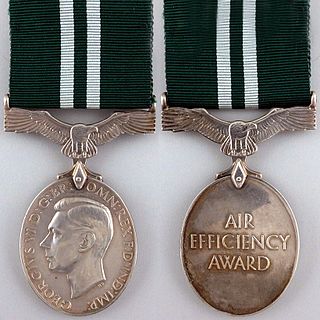
The Air Efficiency Award, post-nominal letters AE for officers, was instituted in 1942. It could be awarded after ten years of meritorious service to part-time officers, airmen and airwomen in the Auxiliary and Volunteer Air Forces of the United Kingdom and the Territorial Air Forces and Air Force Reserves of the Dominions, the Indian Empire, Burma, the Colonies and Protectorates.
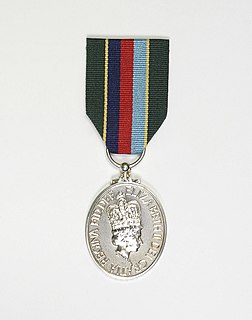
The Volunteer Reserves Service Medal (VRSM) is a medal which may be awarded to members of the Volunteer Reserves of all branches of the British Armed Forces - the Royal Naval Reserve, the Royal Marines Reserve, the Army Reserve and the Royal Auxiliary Air Force. It replaced the separate decorations and medals awarded respectively to officers and other ranks in each of the services - the Royal Navy's Reserve Decoration and Reserve Long Service and Good Conduct Medal, the British Army's Territorial Decoration and Efficiency Medal, and the Royal Air Force's Air Efficiency Award - from 1 April 1999.
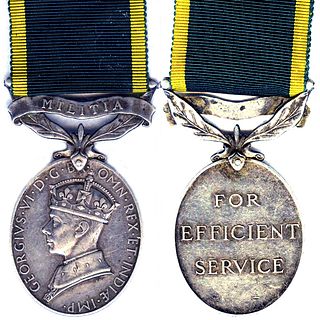
The Efficiency Medal was instituted in 1930 for award to part-time warrant officers, non-commissioned officers and men after twelve years of efficient service on the active list of the Militia or the Territorial Army of the United Kingdom, or of the other Auxiliary Military Forces throughout the British Empire. At the same time a clasp was instituted for award to holders of the medal upon completion of further periods of six years of efficient service.

The Efficiency Medal was instituted in 1930 for award to part-time warrant officers, non-commissioned officers and men after twelve years of efficient service on the active list of the Citizen Force of the Union of South Africa. At the same time, a clasp was instituted for award to holders of the medal upon completion of further periods of six years of efficient service. The medal superseded the Colonial Auxiliary Forces Long Service Medal.

The Colonial Auxiliary Forces Officers' Decoration, post-nominal letters VD, was established in 1899 as recognition for long and meritorious service as a part-time commissioned officer in any of the organized military forces of the British Colonies, Dependencies and Protectorates. It superseded the Volunteer Officers' Decoration for India and the Colonies in all these territories, but not in the Indian Empire.

The Colonial Auxiliary Forces Long Service Medal was instituted by Queen Victoria in 1899 as a military long service award for part-time members of all ranks in any of the organized military forces of the British Colonies, Dependencies and Protectorates throughout the British Empire. The medal gradually superseded the Volunteer Long Service Medal for India and the Colonies in all these territories, with the exception of the Isle of Man, Bermuda and the Indian Empire.

The Efficiency Medal is a long service award for warrant officers, non-commissioned officers, and other ranks of the New Zealand Territorial Force. The medal is awarded for twelve years of continuous and efficient service. First awarded in 1931, it was a replacement for the Colonial Auxiliary Forces Long Service Medal, which was first awarded in 1902. New Zealand is one of the few countries that continues to award the Efficiency Medal.
